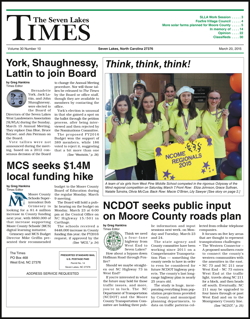 Moore County and the Town of Robbins find themselves on the verge of a long-awaited conversation about how Robbin's water resources can be used to meet the County's long-term water needs. But it's not clear that the County's Board of Commissioners have agreed among themselves what a water deal would look like.
Moore County and the Town of Robbins find themselves on the verge of a long-awaited conversation about how Robbin's water resources can be used to meet the County's long-term water needs. But it's not clear that the County's Board of Commissioners have agreed among themselves what a water deal would look like.
The County and Town Board's of Commissioners will meet in a special meeting set for Monday, April 16 to discuss water options.
During the Moore County Board's Tuesday, April 3, meeting, Commissioner Craig Kennedy presented the rough outlines of a deal that would include the follow parameters:
• Robbins would keep all their current customers and infrastructure.
• Robbins would grant the County access to the town's reservoir, and the County would "commit to the town of Robbins that we would update the intakes on Bear Creek and Cabin Creek and we would commit to keeping that reservoir full."
• The County would acquire a site for a new water treatment plant to treat water pulled from the Robbins reservoir and install a line to bring that water to Southern Moore County.
• The County would sell the Town water at a bulk rate for distribution to Robbins customers.
"There would be no money changing hands," Kennedy said. "What we are offering would be very minimal," Kennedy said. "We are more or less looking for a partnership up there. I think that is what they are expecting from us."
Can the County Afford the Robbins Option?
But Commissioner Tim Lea questioned whether a Robbins solution for the County's water needs is worth the investment. Relying on projected costs developed by Public Utilities Director Randy Gould, Lea noted that the scenario Kennedy described is estimated to cost nearly $14.5 million to bring the County an addition 1.1 mIllion gallons per day [GPD] of water.
Longer term, using that new County water plant in Robbins to treat water pulled from a run-of-river intake on the Deep River could deliver an additional 2.2 million GPD, but would add another $15 million to the cost.
Adding in the interest on the loans the County would undoubtedly need in order to pay for that infrastructure, Lea said the total cost of the project could approach $40 million.
Gould's projections of future demand for water indicate the County will need an additional one million GPD to meet maximum daily demand in ten years and an additional two million GPD to meet 30-year demand.
The County can obtain another one million GPD under an existing contract with Harnett County, meeting its ten year needs, by installing just $1.5 million in new infrastructure.
And exercising either that option — or drilling new wells — may be necessary in the short term, Lea suggested, because "even if we struck a deal with Robbins today, it was going to take five, six, seven years before we could even get to the point of pumping water through pipes."
"Unless I missed a meeting," Lea continued, "I haven't understood that the Board had made a decision that Robbins is the option that we are looking at long term . . . . I'm not sure we are ready to make an offer to anyone."
In contrast to Kennedy's perception of what Robbins would want in a water deal with the County, Lea said he believed the Town would want to be compensated for the County's use of its reservoir -- and would in fact rather be in the position, like Southern Pines and Aberdeen, of selling water to the County.
"For us to go to the table . . . with any kind of offer before we understand what Robbins is interested in . . ." Lea said. "I don't make offers until I understand what the total package cost is going to be. cost of the package is. I don't think we are in a position to go and offer anything until we hear what they have to say."
Kennedy said the idea he proposed would not preclude Robbins building their own new water plant and selling water to anyone. He envisioned only that the Town would provide the County with access to the reservoir.
"I think, if we have to buy any assets up there, then Robbins would be off the table completely," Kennedy concluded.
Gould to make presentation
Chairman Larry Caddell asked Gould to be prepared to deliver his presentation on the Robbins options at the meeting.
"I think we need to just go up there and share that information, just to show them what it is going to cost," Caddell said, "and then work out some kind of agreement."
"We need to exhaust the option in Robbins; and, if it doesn't work out, we will go away friends."
Commissioner Picerno asked Gould for some additional analysis of the level of funds Public Utilities has to pay for capital projects.
"When we talk about these options," Picerno said, "it always looked like we had to raise a rate to perform a certain capital expenditure . . . . At the current rates, what kind of capital expansion can we do the the system with no rate increase? In other words, how much money are we generating now in excess of running the system? I don't think I've ever heard that number."
Gould pointed out that Public Utilities already has a long-term plan for capital improvements that utilize its available funds -- and has had to delay some projects, as a sluggish economy has reduced the growth in water revenues.
"Start out with a zero -- no projects -- how much are we generating?'" Picerno asked. "And then maybe the projects that are on board -- what are they eating up? That way we, as Commissioners, sort of know what we have to work with."
"If we potentially have to raise a rate, I want to be able to go out and justify it to a rate user . . . I want information."
